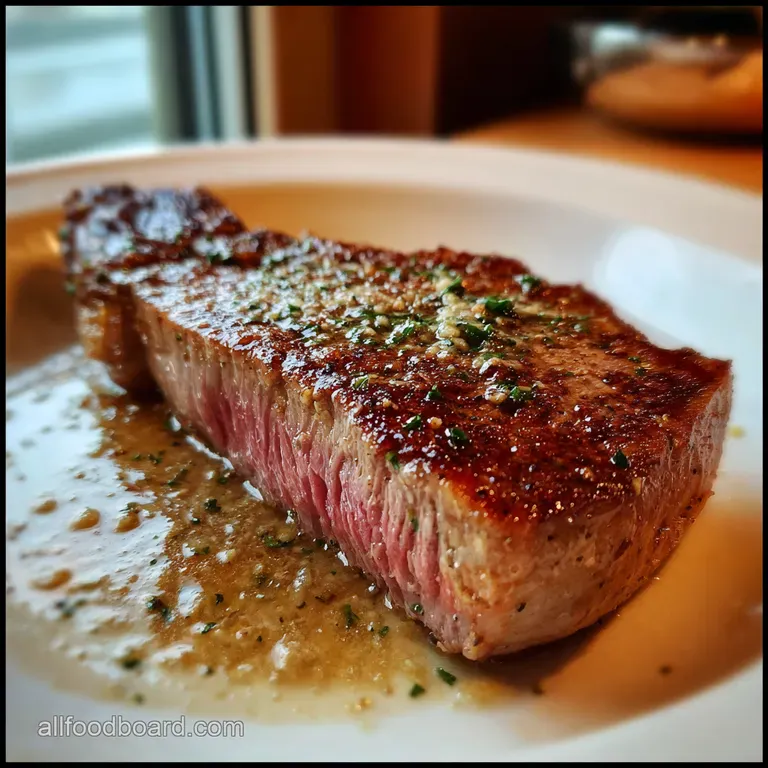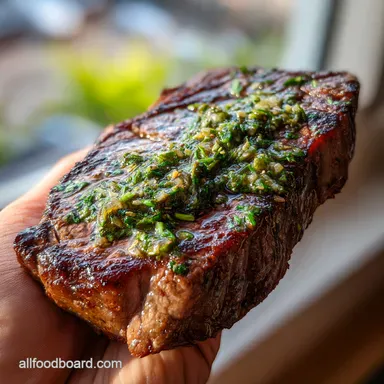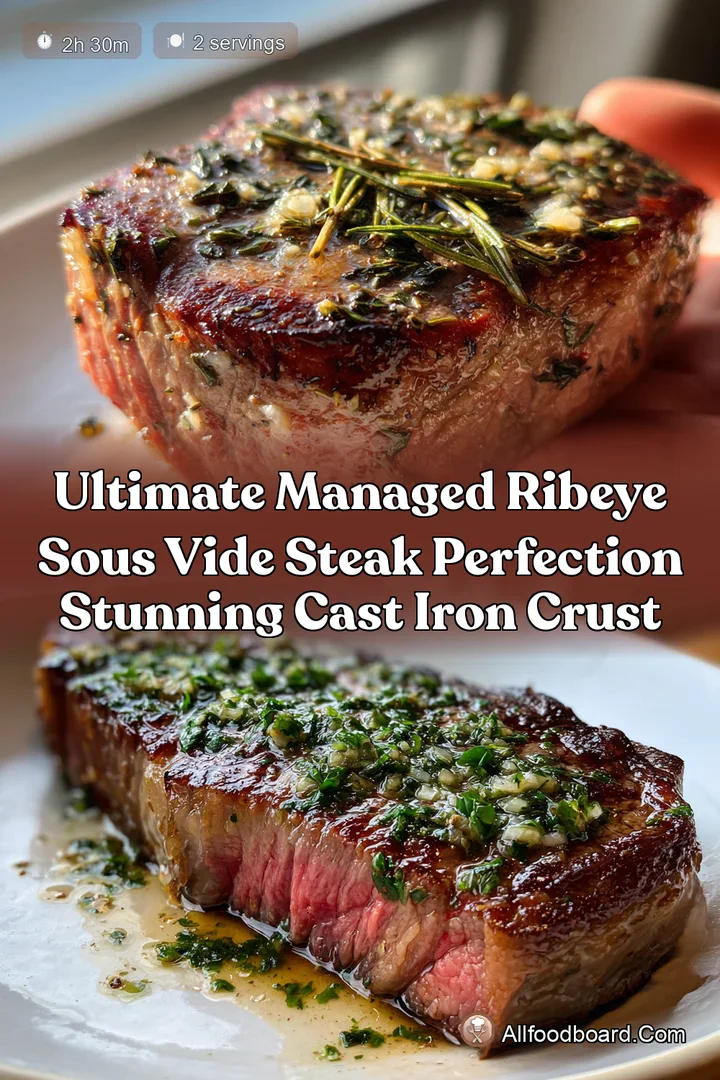The Managed Temperature Ribeye Sous Vide Perfection

The Managed Temperature Ribeye Sous Vide Perfect

Ingredients:
Instructions:
Nutrition Facts
Your Steak Night Just Got a Promotion: The Secret to Sous Vide Steak Perfection
Hands up if you’ve ever paid good money for a glorious ribeye, only to panic and burn it trying to get that perfect crust? Oh my gosh, I have been there! Today, we’re talking about my ultimate kitchen hack: the Managed Temperature Ribeye Recipe .
This method isn't just cooking; it’s quality control. It guarantees you a flawless, edge to edge medium rare ribeye every single time.
Why You Need This Foolproof Steak Cooking Method
For years, I fought the oven and the grill. I suffered through the dreaded grey band—that sad, overcooked ring of meat just under the crust.
Honestly, achieving true steakhouse quality at home felt impossible. But then I discovered the secret weapon: the sous vide bath.
This is the best immersion circulator recipes you will ever make.
This recipe uses a simple two-step process to achieve culinary nirvana. First, we use precision cooking temperature control to get the inside spot-on.
Then, and only then, do we blast the outside with a fierce high-heat sear cast iron skillet technique. It completely separates the tasks of cooking the middle and forming the crust.
Did you know that industry experts estimate nearly 70% of home cooks struggle to achieve perfect internal steak temperature without sacrificing the crust? That's why this "managed" approach is brilliant.
We’ve taken the guesswork right out of it. It’s the ultimate controlled temperature cooking techniques for busy folks.
The Ultimate Benefit: Flavour and Ease
This ribeye recipe is ridiculously easy once you understand the timeline. You prep it in about fifteen minutes. The sous vide steak perfection takes care of itself for two hours—hands-off! Then, you only need ten minutes of active attention for the sear and the luxurious garlic herb pan sauce for steak .
It’s medium difficulty only because you need the right kit, but the technique itself is stress-free.
The results are totally worth the initial setup. The gentle bath leaves the meat incredibly tender. The final sear, coupled with the critical step of learning how to dry steak for perfect crust , ensures maximum texture and flavour contrast.
This technique doesn't just work for steak; it makes you feel like a proper professional chef in your own kitchen!
This recipe is ideal for special occasions or when you simply want to impress someone without risking a kitchen disaster.
We’ve got the internal temperature perfectly managed so you can focus all your energy on developing that dark, delicious crust and building that incredible sauce.
Ready to stop worrying about overcooked steak? Let’s look at what we need...
The Crucial Kit for Sous Vide Steak Perfection
Right, let's talk gear and grub. If you want true sous vide steak perfection , you need the right bits.
This recipe is all about taking control. We achieve the ultimate edge to edge medium rare ribeye every single time.
It's truly a foolproof steak cooking method . No more hovering over a hot pan for ages.
Getting the Good Stuff (Main Ingredients)
This isn't complicated shopping. Focus on quality, not quantity.
Grab two thick ribeyes, around 1.5 inches (38 mm) each. That thickness is key. It lets the steak spend longer in the searing pan without overcooking the middle.
Don’t skimp on the meat quality.
For flavour, you need 1 Tbsp (15 g) of Kosher salt. Seriously, salt it heavily before the bath. Then, add some fresh thyme and rosemary.
These sit right in the sous vide bag with 2 Tbsp (30 g) of butter. That subtle butter bath during the cook? Total heaven.
The Spice Combo Cheat Sheet (Seasoning Notes)
We are keeping it super simple initially. Just salt and pepper pre-bag. The intense flavour happens when we make the garlic herb pan sauce for steak .
The finishing touch requires 4 Tbsp (60 g) of chilled, cubed butter for basting. Use unsalted butter here. You can control the seasoning better.
If you need a quick substitution for the dry red wine in the sauce, use a splash of balsamic vinegar with the beef stock.
It gives that perfect tangy depth. Oh my gosh, the smell when that sauce bubbles up is incredible!
The Gear That Gets You Precision (Equipment Needed)
This managed temperature ribeye recipe requires two non-negotiable bits of kit.
First, you need the circulator. It’s what gives you precision cooking temperature control . I failed so many times trying to pan-cook thick steaks.
Honestly, that little device just clicks in and manages the internal temperature perfectly. This is part of our controlled temperature cooking techniques .
Second, a serious skillet is essential. A high-heat sear cast iron skillet is non-negotiable. It retains the heat you need for an instant crust.
No cast iron? Use the heaviest, thickest pan you own.
Pro Tip: The Moisture Challenge
One last thing on equipment: paper towels. And lots of them. You must learn how to dry steak for perfect crust .
After the sous vide bath, the steak will be damp. This moisture kills the sear. Pat it dry aggressively. This process must be perfectly managed before it hits the heat.
The circulator takes care of the inside; you manage the outside. Welcome to the best immersion circulator recipes club!
Oh my gosh, friends, if there is one thing that stresses me out, it’s spending a fortune on a beautiful piece of meat only to mess up the cooking.
We've all been there, right? That gray band around the outside? Total rubbish.
This is why I am obsessed with the Sous vide steak perfection method. It’s the ultimate kitchen cheat code. It uses precision cooking temperature control to deliver a perfectly uniform steak.
Seriously, we’re talking guaranteed edge to edge medium rare ribeye every single time. This technique is definitely one of the best immersion circulator recipes out there.
It’s a truly foolproof steak cooking method .
Mise en Place: Prepping for Perfection

Before anything else, let’s get organized. This entire recipe relies on separating the cooking phases. We need to manage the internal temperature first, and then manage the crust.
- Dry It Out: Pat your ribeyes completely dry. I mean, aggressively dry. Moisture is the enemy of crust. Put them in the bag with the butter and herbs.
- Set the Bath: Fill your vessel and set your water bath to your preferred doneness. For me, that’s 130° F (54. 4° C) for classic medium-rare. Let the water heat up fully before adding the steaks. This is key to controlled temperature cooking techniques .
The Two-Step Dance: Cook and Crush
This managed temperature ribeye recipe is split into a gentle bath and a fierce fire.
- The Gentle Cook: Drop those bagged beauties into the water bath. Leave them for 90 to 120 minutes . Go put your feet up or, you know, sort out the rest of dinner.
- The Exit: Once the timer sings, take the steaks out and discard the herbs and liquid. This is the most crucial moment for achieving that glorious crust: Pat those steaks bone-dry again! This is How to dry steak for perfect crust . I use about half a roll of kitchen paper. Don’t skip this bit!
- The Sear: Get your high-heat sear cast iron skillet smoking hot. Add your high smoke point oil.
- Sizzle: Place the steak in the pan. Sear for 60–90 seconds without touching it. Flip it, drop the heat, and immediately add butter, garlic, and fresh rosemary.
- Baste: Tilt the pan and spoon that delicious, bubbling fat over the steak for another 60 seconds . This is when the crust deepens and the flavour explodes.
- Rest: Pull the steak and let it rest for 5 minutes . Don't wash the pan! We need those sticky, brown bits.
Pro Tips for Maximum Flavour
Honestly, the managed part is all about the crust. I failed this so many times when I started. Soggy crust? Yuck.
1. The Cast Iron Commitment
You absolutely need a cast iron skillet for this. The heat retention is non-negotiable. If you try this in a thin pan, the temperature will drop instantly when the steak hits, and you will get a steamy, sad crust.
2. The Garlic Herb Pan Sauce
Use the fonds (those brown bits) left in the pan! After the steak is resting, quickly make the garlic herb pan sauce for steak .
Deglaze with a splash of red wine, then add beef stock. Reduce it quickly until it coats the back of a spoon.
It takes about two minutes and elevates the whole meal to restaurant-level goodness.
Recipe Notes: Making Steak Night Stress-Free
Honestly, the best thing about using this controlled temperature cooking technique is that once the steak comes out of the water bath, the hardest part is managed .
You've locked in that perfect edge to edge medium rare ribeye . Now, let's talk about the important bits that turn a great steak into a proper feast.
Plating Like a Pro (And Pairing)
Look, after you’ve nailed the sous vide steak perfection and created that awesome garlic herb pan sauce for steak , you want to show it off, right? Don't drown the steak in sauce.
Slice the rested meat against the grain—always, always—and fan it out beautifully. Then, just drizzle a little sauce over the slices.
Serve the rest of the sauce on the side in a tiny jug, like you’re at a fancy pub.
For sides, keep it classic. I absolutely love this with some proper buttery mash or crispy triple-cooked chips. For a lighter touch, a simple watercress salad cuts through the richness brilliantly.
As for the drink, a big glass of Malbec is the bee's knees; it stands up perfectly to the fat from the ribeye.
Keeping It Safe and Sound
Let’s talk leftovers, if there are any! (Spoiler: there usually aren't.) You need to handle cooked steak gently. Store any remaining steak and the glorious pan sauce separately in airtight containers in the fridge.
They'll be fine for up to 3 days . This method relies on precision cooking temperature control , so don't ruin it with a brutal reheat!
If you try to blast the cold steak back into a high-heat sear cast iron skillet , you’ll end up with shoe leather.
Trust me, I’ve been there. The foolproof steak cooking method for leftovers is simple: slice it thinly while cold, and then flash-warm it gently in a frying pan with a little of the reserved pan sauce.
Alternatively, just serve it cold atop a beautiful salad. It's fantastic.
Easy Swaps and Variations
This core method is so forgiving—it’s the true definition of a managed temperature ribeye recipe . If you’re dairy-free, simply substitute the butter used in the basting and pan sauce with high-quality olive oil or ghee.
The sauce will still deglaze perfectly.
For a low-carb alternative, skip the red wine in the sauce and use a splash of balsamic vinegar mixed with the stock.
And when autumn rolls around? Swap the rosemary and thyme for dried porcini mushrooms and sage in the bag for a totally different, earthy flavour profile.
It makes the best immersion circulator recipes so versatile!
Why This Steak is Good For You
Ribeye isn't the leanest cut, but it's brilliant for energy. It’s packed with high-quality protein, which keeps you feeling full.
Plus, red meat is a fantastic source of iron and B vitamins. Because we use controlled temperature cooking techniques , we minimise the risk of overcooking, which helps retain those natural nutrients.
It’s not just a treat; it’s quality fuel.
Go on, try it! This method takes all the stress out of cooking steak. It guarantees you a gorgeous result every single time. Enjoy that flawless crust and the perfectly cooked inside!

Frequently Asked Questions
I don't have a sous vide machine. Can I still make this perfectly "managed" steak?
No worries, mate, you can still achieve a cracking result, though it requires a bit more supervision! Use the reverse sear method: bake the seasoned steaks low and slow (around 225°F / 107°C) on a wire rack until the internal temperature hits 120°F (49°C). Then, immediately proceed with the aggressive, high-heat pan sear outlined in Phase 3. It's the best way to bypass the sous vide while still managing the internal temperature well.
What’s the secret to getting a proper crust after the steak has been in the water bath? Mine always comes out grey.
A failed crust is usually down to one thing: moisture. After the gentle sous vide bath, the surface of your ribeye is wet, and you must treat it like a damp sponge. Pat the steak aggressively dry with paper towels—the drier the better! Ensure your cast iron pan is literally smoking hot before the high smoke point oil goes in, and be brave; sear for a full 60–90 seconds per side without fussing, allowing that magnificent maillard reaction to occur.
How does the ‘managed’ temperature method guarantee the steak is cooked exactly to medium-rare?
The beauty of this managed cooking technique is that the water bath prevents the steak from ever exceeding the temperature you set (130°F / 54.4°C for medium-rare). Once the steak’s core reaches the bath temperature, it simply holds it there, meaning you literally cannot overcook it, even if you leave it in for an extra hour. Just make sure the steaks have been in long enough for the heat to penetrate the centre (90 minutes for 1.5 inches is spot on).
I’m entertaining guests; can I prep the steaks ahead of time to minimize the pre-dinner faff?
Absolutely, this is where sous vide shines for dinner parties! You can complete Phase 1 and 2 entirely ahead of time. Once the steaks are cooked and removed from the bath, immediately plunge the sealed bags into an ice bath for 10 minutes to cool them rapidly (this prevents bacterial growth). Store the cooled bags in the fridge for up to three days. When it's time to serve, simply dry the steaks and proceed straight to the high-heat sear and sauce preparation.
The nutritional info shows a lot of fat. Is there a way to make the garlic-herb pan sauce a little lighter?
You can certainly dial back the richness without losing all the flavour, though a bit of fat is necessary for the basting process. To lighten the pan sauce, skip the final 4 Tbsp of chilled butter added during the basting step. Instead, use only oil and the shallots/garlic to build the fond, and thicken the finished beef stock reduction by stirring in a cornstarch slurry (1 tsp cornstarch mixed with 1 Tbsp cold water) right at the end for a lighter gravy texture.